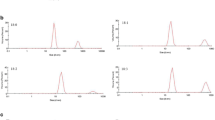Abstract
Phospholipids protect the gastric mucosa by forming a proton-repellent hydrophobic layer on its luminal surface. We have recently shown that two molecular species of phosphatidylcholine (PC), PC16:0/18:1, and PC16:0/18:2, but not PC16:0/16:0, are predominantly released into gastric mucus. We investigated whether these molecular species in mucus are modified by dietary fat. Rats were fed (for three weeks) a diet supplemented with either 10% cod liver, palm, or sunflower oil, or 10% corn starch as a control. In tissue, cod liver oil decreased PC16:0/20:4 and PC18:0/20:4. Cod liver oil and palm oil increased PC16:0/18:1, whereas sunflower oil decreased PC16:0/18:1. Palm oil additionally decreased PC16:0/18:2, whereas the other diets had no effect on PC16:0/18:2. In mucus, however, PC16:0/18:1 and PC16:0/18:2 were not significantly altered by any diet. They were increased over tissue values and comprised 37.6±3.3 and 33.1±1.4 mol% in controls. PC16:0/16:0 was lower in mucus than in mucosa and even decreased by cod liver oil (1.2±0.2 vs. 2.7±0.3 mol%;P<0.01). We conclude that PC16:0/18:1 and PC16:0/18:2 are modified by dietary fat in tissue. In gastric secretions, however, PC16:0/18:1 and PC16:0/18:2 are kept constant and together comprise 70 mol% of the released PC species, whereas PC16:0/16:0 does not play a role for the gastric hydrophobic barrier under any dietary treatment. Additionally, cod liver oil decreases the content of PC16:0/20:4 and PC18:0/20:4 in gastric mucosa, thereby possibly decreasing the formation of eicosanoids.
Similar content being viewed by others
Abbreviations
- HPLC:
-
high-performance liquid chromatography
- PC:
-
phosphatidylcholine
- PE:
-
phosphatidylethanolamine
- PG:
-
phosphatidylglycerol
References
Davenport, H.W., Warner, H.A., and Code, C.F. (1964) Functional Significance of Gastric Mucosal Barrier to Sodium,Gastroenterology 47, 142–152.
Fromm, D. (1981) Gastric Mucosal Barrier, inPhysiology of the Gastrointestinal Tract (Johnson, L.R., ed.), pp. 733–748. Raven Press, New York.
Hudson, N., Hawthorne, A.B., Cole, A.T., Jones, P.D.E., and Hawkey, C.J. (1992) Mechanisms of Gastric and Duodenal Damage and Protection,Hepato-Gastroenterol. 39, 31–36.
Bernhard, W., Schulte, H., Piller, M., and Sewing, K.F. (1996) Synthesis and Release of Phosphatidylcholine by Isolated Porcine Gastric Mucous Cells in Primary Culture,Eur. J. Clin. Invest 26, in press.
Hills, B.A., Butler, B.D., and Lichtenberger, L.M. (1983) Gastric Mucosal Barrier: Hydrophobic Lining to the Lumen of the Stomach,Am. J. Physiol. 244, G561-G568.
Kao, Y.C., and Lichtenberger, L.M. (1991) Phospholipid and Neutral Lipid Containing Organelles of the Rat Gastroduodenal Mucous Cells. Possible Origin of the Hydrophobic Mucosal Lining,Gastroenterology 101, 7–21.
Scheiman, J.M., Kraus, E.R., Bonnville, L.A., Weinhold, P.A., and Boland, C.R. (1991) Synthesis and Prostaglandin E2-Induced Secretion of Surfactant Phospholipids by Isolated Gastric Mucous Cells,Gastroenterology 100, 1232–1240.
Mauch, F., Bode, G., Malfertheiner, P., and Ditschuneit, H. (1991) Ultrastructural Characterization of a Surfactant-Like Layer in the Human Gastric Epithelium,Digestion 49, 88.
Bernhard, W., Postle, A.D., Linck, M., and Sewing, K.F. (1995) Composition of Phospholipid Classes and Phosphatidylcholine Molecular Species of Gastric Mucosa and Mucus,Biochim. Biophys. Acta 1255, 99–109.
Rogers, C., Pihan, G., Peskar, B.M., and Szabo, S. (1991) A Possible Role for Leucotrienes in the Pathogenesis of Acute Gastric Hemorrhagic Mucosal Lesions Induced by Ethanol, HCl, NaOH or Aspirin: Pharmacology, Biochemical and Vascular Studies with Eicosapentaenoic Acid in the Rat,Exp. Clin. Gastroenterol. 1, 107–117.
Stoffel, W., Chu, F., and Ahrens Jr., E.H. (1959) Analysis of Long-Chain Fatty Acids by Gas-Liquid Chromatography, Micromethod for Preparation of Methyl Esters,Anal. Chem. 31, 307–308.
Folch, J., Lees, M., and Sloane Stanley, G.H. (1957) A Simple Method for the Isolation and Purification of Total Lipids from Animal Tissues,J. Biol. Chem. 226, 497–509.
Bligh, E.G., and Dyer, W.J. (1959) A Rapid Method of Total Lipid Extraction and Purification,Can. J. Biochem. Physiol. 37, 911–917.
Bartlett, G.R. (1959) Phosphorus Assay in Column Chromatography,J. Biol. Chem. 234, 466–468.
Postle, A.D. (1987) Method for the Sensitive Analysis of Individual Molecular Species of Phosphatidylcholine by High-Performance Liquid Chromatography Using Post-Column Fluorescence Detection,J. Chromatogr. 415, 241–251.
Hills, B.A., and Kirwood, C.A. (1992) Gastric Mucuosal Barrier: Barrier to Hydrogen Ions Imparted by Gastric Surfactantin vitro, Gut. 33, 1039–1041.
Hamm, H., Fabel, H., and Bartsch, W. (1992) The Surfactant System of the Adult Lung: Physiology and Clinical Perspectives,Clin. Invest. 70, 637–657.
Egberts, J., Sloot, H., and Mazure, A. (1989) Minimal Surface Tension, Squeeze-Out and Transition Temperatures of Binary Mixtures of Dipalmitoylphosphatidylcholine and Unsaturated Phospholipids,Biochim. Biophys. Acta, 1002, 109–113.
Fisher, J.H., and Mason, R. (1995) Expression of Pulmonary Surfactant Protein D in Rat Gastric Mucosa,Am. J. Respir. Cell Mol. Biol. 12, 13–18.
Schepp, W., Peskar, B.M., Trautmann, M., Stolte, M., Hagenmuller, F., Schusdziarra, V., and Claussen, M. (1991) Fish Oil Reduces Ethanol-Induced Damage of the Duodenal Mucosa in Humans,Eur. J. Clin. Invest. 21, 230–237.
Lawson, D.L., Mehta, J.L., Saldeen, K., Mehta, P., and Saldeen, T.G. (1991) Omega-3 Polyunsaturated Fatty Acids Augment Endothelium-Dependent Vasorelaxation by Enhanced Release of EDRF and Vasodilator Prostaglandins,Eicosanoids 4, 217–232.
Engler, M.B. (1992) Effects of Omega-3, Omega-6 and Omega-9 Fatty Acids on Vascular Smooth Muscle Tone,Eur. J. Pharmacol. 215, 325–328.
Bernhard, W., Linck, M., Beinborn, M., Schünemann, P., and Sewing, K.F. (1994) Phospholipid Synthesis in Isolated Porcine Gastric Mucous Cells,Pharmacology 48, 176–186.
Dial, E.J., and Lichtenberger, L.M. (1988) Surface Hydrophobicity of the Gastric Mucosa in the Developing Rat—Effects of Corticosteroids, Thyroxine, and Prostaglandin E2,Gastroenterology 94, 57–81.
Hudson, N., Hawthorne, A.B., Cole, A.T., Jones, P.D.E., and Hawkey, C.J. (1992) Mechanisms of Gastric and Duodenal Damage and Protection,Hepato-Gastroenterol, 39, 31–36.
Gyires, K. (1994) Some Factors that May Mediate or Modify the Gastrointestinal Mucosal Damage Induced by Non-Steroidal Anti-Inflammatory Drugs,Agents Actions 41, 73–79.
Author information
Authors and Affiliations
About this article
Cite this article
Bernhard, W., Postle, A.D., Linck, M. et al. Rat gastric hydrophobic barrier: Modulation of phosphatidylcholine molecular species by dietary lipids. Lipids 31, 507–511 (1996). https://doi.org/10.1007/BF02522644
Received:
Accepted:
Issue Date:
DOI: https://doi.org/10.1007/BF02522644




